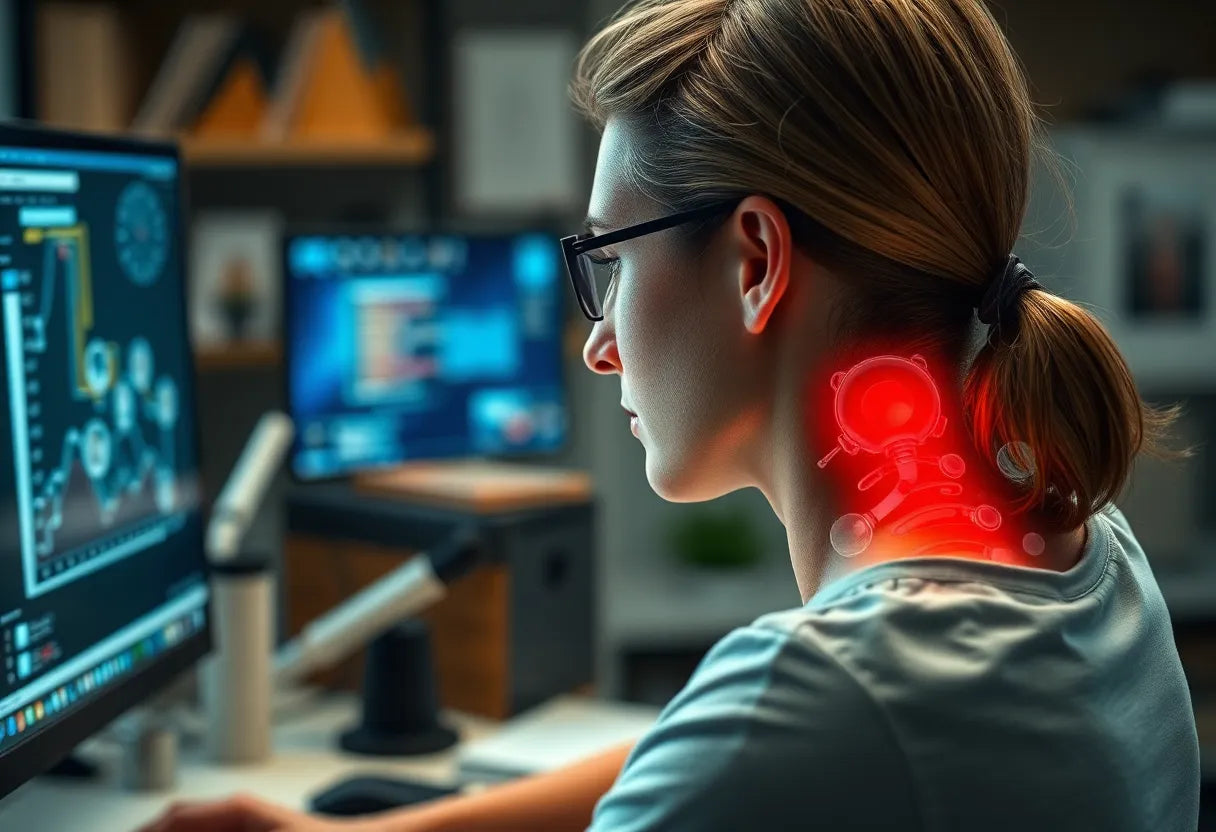In today's fast-paced digital world, neck pain has become an all-too-common complaint among desk workers. As we spend increasing hours glued to our screens, the prevalence of this issue has skyrocketed, giving rise to what many now refer to as "tech neck." This modern ailment stems from the strain placed on neck muscles due to prolonged screen time and poor posture, making it a significant concern for anyone tied to a desk job.
understanding the problem of neck pain from desk work
The root cause of neck pain in desk-bound environments often boils down to poor posture. When you sit hunched over your computer with your head jutting forward, it places undue stress on the neck and shoulder muscles. This head-forward position, common among those engrossed in their work, can lead to chronic discomfort and exacerbate existing pain. However, the good news is that with a few ergonomic adjustments, you can significantly reduce this strain and improve your overall comfort.
Ergonomics, the science of designing a workspace to fit the user's needs, offers practical solutions to combat neck pain. By making simple changes to your workstation setup, you can alleviate the discomfort associated with desk work. These adjustments not only promote better posture but also enhance productivity by creating a more comfortable working environment.
setting the stage for ergonomic solutions
In the following sections, we will delve into practical solutions that can help you escape desk-related neck pain. From adjusting your monitor height and chair position to incorporating regular breaks and exercises into your routine, these tips are designed to be easily implementable and highly effective. By the end of this guide, you'll have a clear understanding of how to optimize your workspace for comfort and health, allowing you to work more efficiently and pain-free.
Stay tuned as we explore these ergonomic tweaks in detail, providing you with the tools you need to transform your work environment and bid farewell to neck pain. Whether you're working from home or in an office, these insights will empower you to take control of your well-being and enhance your daily work experience.
causes of neck pain from desk work
One of the most significant contributors to neck pain among desk workers is poor posture. When seated at a desk, many individuals adopt a head-forward position, where the head extends in front of the shoulders. This posture places excessive strain on the cervical spine and surrounding muscles, leading to discomfort and potential long-term issues.

Men's Posture Shirt™ - Black
Improves posture, activates muscles, and helps relieve neck, back and shoulder pain.
Closely related to this is the phenomenon known as "tech neck." This condition is characterized by the repetitive stress injury caused by looking down at screens for extended periods. The increased use of smartphones, tablets, and laptops means that many people are spending hours each day with their necks bent forward, exacerbating the strain and leading to chronic pain.
Prolonged screen use further compounds these issues. The human head weighs about 10 to 12 pounds, and for every inch the head tilts forward, the pressure on the neck doubles. Over time, this can lead to muscle fatigue, inflammation, and even structural changes in the spine, making it crucial to address these habits early on.
ergonomic solutions for neck pain relief
workstation setup
Creating an ergonomic workstation is a fundamental step in alleviating neck pain. The height and distance of your monitor are critical; the top of the screen should be at or slightly below eye level, and it should be about an arm's length away. This positioning helps maintain a neutral head position, reducing strain on the neck.
Adjusting your chair height is equally important. Your feet should rest flat on the floor, with knees at a 90-degree angle. An ergonomic chair with proper lumbar support can encourage better posture. Consider using a desk that allows for easy adjustments to accommodate different tasks and movements throughout the day.
posture adjustments
Maintaining a neutral spine position is essential for reducing neck pain. This means aligning your ears with your shoulders and keeping your back straight. Avoid slouching or leaning forward, which puts additional pressure on the neck and shoulders. Regularly check your posture and make adjustments as needed.

Women's Posture Shirt™ - Nude
Activates muscles, relieves tension, and helps maintain upright posture in daily work.
regular breaks and movement
Incorporating regular breaks into your work routine can significantly reduce tension and prevent neck pain. Aim to stand up and move around every 30 minutes. Simple neck and shoulder exercises, such as gentle rotations and shoulder shrugs, can help alleviate stiffness and improve circulation.
visual aids for ergonomic success
To further assist in creating an ergonomic workspace, consider using visual aids. A diagram illustrating the ideal ergonomic workstation setup can serve as a helpful reference. Ensure that key ergonomic tips, such as monitor positioning and posture guidelines, are easily accessible for quick reminders.
By implementing these ergonomic solutions, you can significantly reduce the risk of neck pain associated with desk work. These adjustments not only promote physical well-being but also enhance productivity and overall job satisfaction. Stay tuned for additional tips and lifestyle adjustments in the next section, designed to further protect your neck health and improve your work experience.
additional tips for preventing neck pain from desk work
While ergonomic workstation setups play a crucial role in mitigating neck pain, additional strategies can further enhance your comfort. One key aspect is the positioning of your devices. Ensure that laptops and tablets are positioned to avoid looking down, which can exacerbate neck strain. Using stands or external keyboards can help maintain a more natural head position, reducing the risk of "tech neck."
Incorporating lifestyle adjustments is equally important. Engaging in regular physical activity outside of work hours can strengthen muscles and improve posture. Activities such as yoga, swimming, or even a daily walk can help relieve tension and promote overall well-being. Additionally, stress management techniques like deep breathing exercises or meditation can reduce muscle tension and contribute to a more relaxed posture.
concluding thoughts on neck pain prevention
Incorporating ergonomic principles into your daily routine is essential for preventing neck pain from desk work. By optimizing your workspace and being mindful of your posture, you can significantly reduce discomfort and enhance your productivity. Regularly assess your workspace and make necessary adjustments to ensure it continues to meet your ergonomic needs. Remember, small changes can lead to significant improvements in your overall health and well-being.
frequently asked questions
What is the best chair for preventing neck pain?
Look for chairs with adjustable features, lumbar support, and a headrest to help maintain proper posture and reduce neck strain.
How often should I take breaks to prevent neck pain?
Ideally, take a 5-minute break every 30 minutes of desk work to stretch and move around, which helps alleviate tension.
Are there specific exercises that help with neck pain from desk work?
Yes, exercises such as neck stretches, shoulder shrugs, and gentle rotations can help relieve tension and improve flexibility.
Can ergonomic aids really make a difference?
Ergonomic aids can significantly improve posture and reduce strain on neck muscles, making them a valuable investment for long-term comfort.
What should I do if my neck pain persists despite ergonomic adjustments?
If neck pain persists, consult a healthcare professional for a personalized assessment and treatment plan, which may include physical therapy or other interventions.
Kilder
- Gupta, N., et al. (2016). "Ergonomic Interventions for Preventing Musculoskeletal Disorders." Journal of Ergonomics.
- Goodpath. (2023). "Work from Home Ergonomics: A Guide to a Healthier Workspace."
- Lee, K., & Park, J. (2025). "Impact of Digital Device Usage on Neck Pain." Frontiers in Pain Research.
- Mayo Clinic. (2023). "Office Ergonomics: Your How-To Guide."
- Spine-Health. (2023). "Workplace Ergonomics and Neck Pain."
- Smith, J. A., & Brown, L. (2018). "Physical Therapy Interventions for Neck Pain." Physical Therapy Journal.
- NewYork-Presbyterian. (2023). "How to Prevent Tech Neck."
- Physio-Pedia. (2023). "Office Ergonomics and Neck Pain."
- Aurora Health Care. (2023). "Neck Pain Prevention Tips."
- Mayo Clinic Health System. (2023). "Effect of Technology on Your Neck."


















